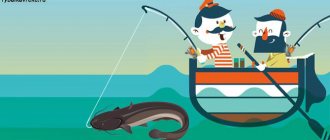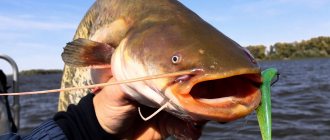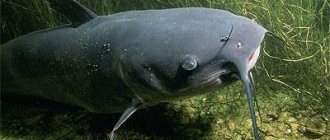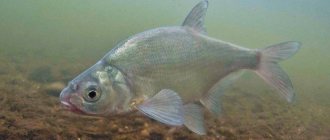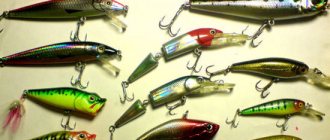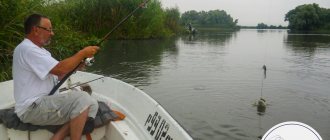Donka for catfish is the very first tackle with which an angler tried to catch this giant of our freshwater reservoirs. The effectiveness of the gear has not lost its relevance in our time, having included modern materials and progressive equipment that help control the bite and confidently fight the caught fish. Experienced somyatniks collect donka for catfish with their own hands, taking into account the specifics of the reservoir chosen for fishing and the habits of the fish population living there. Hunting for catfish is a serious undertaking that requires careful consideration of every detail, including selecting a place to install fishing equipment, assembling the gear itself, and determining the optimal type of bait, which is currently of particular interest to the fish in its diet.
Equally important attention is paid to knowledge of trophy fishing techniques, which are distinguished by a scrupulous approach to the safety of getting to the shore and subsequent storage of the caught fish. Indeed, in most cases, it happens that spotting and catching a catfish is much easier than coping with the subsequent landing of a powerful barbel without losing the tackle and without getting injured from cuts from the cord of your hands. We will cover all the nuances of fishing presented above in the article offered to the reader, trying to make catfish fishing both successful and safe in all its respects.
When to catch catfish on a donk
Catching catfish on a donk from the shore has its own clear time frame, which is limited to two summer months, including July and August, and covering the first half of September. This is due to the specific life rhythms of heat-loving fish and the possibilities of the structure and installation of the donkey itself for catching catfish. In view of the fact that structurally bottom tackle is used to fish on flat areas of a reservoir, and as is known, the mustachioed giant prefers underwater holes and ditches under steep banks, it is worth clearly knowing the time when fish enter flat-bottomed and relatively shallow water areas, which happens during the above-mentioned periods of summer and autumn.
At this time, catfish feed at twilight and at night on flat shallows with very warm water, emerging from holes and snags from the main river channels and fast currents. Fishing for catfish from the shore is planned for a couple of days throughout the day. Fish are more active in the dark, but large catfish are possible during the pre-storm period and during the day, while small catfish can successfully bite, regardless of the intensity of illumination.
Important! Cloudy weather is preferable to bright and hot sunny days. A sprinkling of fine warm rain and a light wind that makes ripples on the water always stimulate biting activity. Sharp cold snaps, as well as drops in atmospheric pressure, make the bite passive and unstable.
Bait
Since catfish are, after all, a predatory fish, appropriate bait is needed:
- Little squinters.
- Ide.
- Asp.
- Pieces of other fish. The only criterion in this case is that the fish is fresh.
- Crow giblets. This bait is good to use in the fall and before using the offal, they should first be smoked over a fire.
- Meadow worms. Very good for spring fishing.
- Live frog. To keep it alive longer, the frog needs to be grabbed not only by the mouth, but also by the body. Catfish react better to a live frog.
- Green locust. Often used in summer.
- Beef liver.
- Raw spleen.
- Leeches.
- Shellfish meat.
- Lamprey larvae.
As you can see, there are a huge number of baits and at any time of the year you can choose the appropriate treat for catfish. When hunting for catfish, it is not uncommon for a pike to be caught on a hook. So, if you wrap pike guts around the shank of a fist-sized hook, this will also make an excellent bait.
The catfish searches for its food using smell and touch, and its long whiskers help it in this. Thus, to enhance the taste of the bait, it is additionally treated with catfish attractants.
Places suitable for catching catfish
Bottom tackle for catfish is installed on the flat bottom of a reservoir, therefore, the habitat of the mustachioed fish must be looked for taking into account these terrain features. As a rule, promising fishing spots are quiet river backwaters, approaching holes in the river bed and areas of snags. Smooth exits of the bottom from deep areas to coastal shallows should also be included in the range of fishing areas under consideration. On lakes, the habitats of giants look like vast backwaters cutting deep into the coastline, opening onto the shore as sandy beaches, the edges of which are fenced on the sides with a wall of reeds or sedges. On reservoirs, promising places will be dams and concrete-reinforced banks that go straight into the water. A depth of two meters is sufficient for feeding both small individuals and especially large specimens.

Important! For installation of gear, hard banks with convenient entries into the water are selected for optimal opportunities for landing already caught fish.
Fishing technique
It’s worth going together to catch catfish using kwok. If a large catfish bites, it is almost impossible to pull it out alone, so we bait the tackle and lower it to a depth of 5-7 meters. Under no circumstances should we wrap fishing line around our hand. If a large catfish bites, it can drag you away. Next, we begin to squawk, make three sharp blows and pause for 20 seconds. We immerse the quok no more than 10 cm in water. If there is no bite at a promising place, be sure to return to this place a little later and try again.
As soon as the catfish hears the sound of a quok, it rises up and meets the bait on its way. He grabs it and goes into the depths, this is a bite. More precisely, it just pulls down and that’s it. Next, we take a short pause, allowing him to swallow the bait more forcefully, and sharply hook him. We make a sharp but short hook.
A large catfish can bite with a very strong jerk, you need to be prepared for this so as not to pull the tackle.
After hooking, we release the catfish, and then begin to fish it out. It all depends on the size of the fish caught. If it’s 10-15 kg, then feel free to pull it out, if it’s larger, then let it get tired and only then pull it out.
Two types of bottom gear for catching catfish
The gear for catching catfish on a donk can be made in two versions. The first type of gear includes the construction of donks using the classical method, when the cord is equipped with leashes and a weight and tied on the shore to a pole rigidly installed in the ground. Varieties of the classic method of bottom fishing are the elastic donka and the multi-hook net.
The second option is the installation of bottom equipment using a rod and reel cord as a basis, which in its modern form looks like installing equipment on a spinning rod or feeder gear. The use of both types of gear does not differ much in terms of fishing conditions; the main distinguishing feature is the multi-hook nature of the classic gear and only a single hook of the catch. It is also worth noting the greater coverage of the fishing area by the classics of the bottom genre and the precise installation of the bait supply on the hook. But installing the equipment on the rod allows you to use a feeder with bait and fish in a bottom hole, which is impossible to do with a classic donka. We will consider the design features of equipment types in more detail in the further description of the topic.
Donka with a rod
Bottom tackle for catching catfish using a rod consists of a powerful, heavy fiberglass plug base, which includes a massive inertia-free reel. To install gear on the shore of a reservoir, all kinds of stands are used. They are used starting from an ordinary wooden flyer stuck deep into the ground and ending with a rod-pod for a couple of similar rods. The installation itself is simple and consists of a hundred-meter piece of braided cord, a blind sinker, a powerful hook and a float to hold and control the installation of bait on catfish above the bottom of the reservoir. After casting the equipment, the cord is equipped with a bite alarm, which can be either a bell or an electronic buzzer.
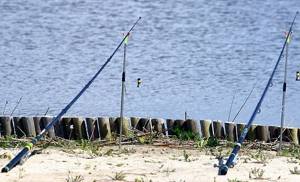
Important! To ensure the safety of the rod from being pulled into the water by a fish that has taken the bait, it is recommended to equip the butt of the tackle with a safety carabiner, which is hooked with a cable or rope to fixed elements installed on the shore of the reservoir, which can be trees, cars and dam structures.
Zakidushka without a rod
In the classic version, donkey equipment for catfish is stored on a wooden reel, which during fishing is used as an element for attaching gear on the shore. About hundreds of meters of the main braided cord are wound onto the reel, which is supplied with leashes made of monofilament fishing line, equipping them with small floats for lifting the bait from the bottom and directly with the hook itself. The distance between the leads is at least five meters, which allows you to fish the bottom most effectively. The cord can be attached to the load either directly or through an elastic band, popularly called a model, which allows, when stretched, to serve leashes with hooks without removing the load from the water. Having secured the reel with a cord rigidly fixed to it to a support on the shore, a shock-absorbing loop is arranged. To do this, use a meter-long piece of rope, tied between a one and a half meter bend of the main fishing line. After casting, the line of the tackle is pulled all the way and equipped with an alarm.
Important! It is advisable to use combined alarms, sound and light, since catfish fishing mostly occurs in the dark, and installing a firefly allows you to more accurately and accurately determine the triggered gear.
Choosing gear
Bottom tackle in skillful hands is a catchy tool, so it is often used when catching catfish. At the same time, the “donka” is an inexpensive device, which makes it very accessible. If we compare it with a feeder, we can note that about one dozen bottom gear is bought for this price.
There are two main types of “donoks”:
- With a rod.
- A bait that does not have a rod.
The design option that the rod has can be characterized as follows:
- For beginners, a donka with a rod is ideal;
- you should pay attention to the fact that large specimens can have a very large weight, which the fishing rod must correspond to;
- You also need to remember that the reel and line are selected based on the possible weight of the fish. If they do not match the loads, then you will not be able to catch large fish.
Often the tackle is equipped with a monofilament fishing line, the thickness of which should be selected in the range from 0.5 to 1 millimeter. The braid can be selected within the range of 0.5 to .8 millimeters. When choosing a leash, you should pay attention to the smaller diameter.
The weight of the sinker used can vary from 100 to 150 grams. The large weight of the cargo and other aspects of the gear used determine that the bait is delivered to the fishing site by boat.
If catfish fishing takes place on a river without the need for long-distance casting of bait, ordinary bottom gear is used, which many call casting. Its features include:
- The gear is inexpensive and simple.
- Despite the simplicity of the design, you need to have certain skills to use it. If you handle it without due care, there is a possibility of overlaps and tangling.
Quite often a nylon thread is used as a fishing line, and a fishing line with a diameter of 0.5 to 0.8 millimeters is used as a leash. A single, double or triple hook, which is made of durable metal, is attached to the created leash. The size of the sting is selected in accordance with the weight of the catfish being caught.
How to make donka for catfish
The construction of bottom gear requires a certain approach to the reliability of the material used in the collection. Since the catch can be significant in size and weight, and even provide strong resistance when fishing, you must initially plan on using accessories with an increased durability life. The thinness and miniature size of the equipment will allow you to attract and force the catfish to take the bait, but it will be almost impossible to remove it from the water. Somyatniks, adequately understanding these contradictions, consciously and deliberately go for the device of rougher installations, thereby reducing the likelihood of a bite, but increasing the success of capture. Let's look at how to properly make a donk for catfish using the example of the options for selecting elements of tackle recommended below, focusing on describing the characteristics and parameters of each of them in more detail.
Fishing rod for catfish
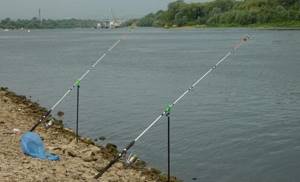
As reliable rods, we advise you to choose feeder versions of heavy carp plug gear no longer than three meters with high tests and medium types of action, which will allow you to quickly hook a fish that has taken the bait and at the same time, without fear of breakage fishing rods, exhaust the fish with a long struggle, using the ability to absorb shocks with a soft form of tackle. Reinforced rings, as well as the massive butt of the fishing rod, should not confuse the fisherman, because the intended catch will not tolerate the thinness of the tackle and will crush it at any opportunity.
Reel for catfish
Like the rod itself, the catfish reel is borrowed from carp fishing. The tackle is equipped with a massive spinning rod with a capacious spool and the ability to clip the cord. The volume of the spool should easily be able to accommodate hundred-meter sections of braided cord with a diameter of at least 0.3 mm. A prerequisite is the presence of a baitrunner reel and, of course, a friction brake in the device, which will protect the gear from loss and help more efficiently deal with caught fish.
Important! The gear ratio is not so important in this type of fishing and can be as small as desired, the main thing is that the traction force allows you to hold large masses without exposing the mechanism of the product to critical loads.
Fishing line for catfish
Rigid braided cords are more efficient in catfish fishing, allowing for finer control of fishing and providing a reliable feeling when fighting strong fish. Damping the efforts of a caught trophy is largely entrusted to the rod and reel, but preserving the catch directly depends on the parameters of the fishing line. Braided cords are used, starting from 0.3 mm. The color of the braid does not play a significant role, but shades of green tones are more acceptable, less noticeable in warm, algae-colored standing summer waters. At least one hundred meters of fishing line are wound onto the spools, avoiding knots and abrasions in its structure, which will significantly reduce the breaking loads of the accessory.
Hooks for catfish
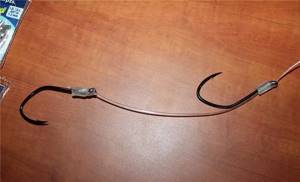
Features of catching large catfish are the ability to use large and elastic hooks that reliably resist bending. On donks, hooks with a long shank made of thick wire and a sealed ring of a fastening element are used.
Important! The hook for catfish should have the tip bent inside its radius to reduce the likelihood of the bait bait spontaneously coming off.
The sharpened edge of the accessory allows you to avoid idle bites when the fish tries the bait, squeezed by the predator’s mouth in the area of the brush made of small and hard teeth.
Sinker for catfish
Lead forms in the form of cones and pyramids with the possibility of being firmly attached to the fishing line of the tackle are used as weights for hooks. The weights are selected based on the weight of the bait and casting distance. The method of mounting the load using the blind method does not in any way affect the number of bites, because even small catfish can easily lift hundred-gram lead ingots when biting without regard for caution, but it adds reliability to the gear, eliminating unnecessary friction of sliding loading options on the surface of the cord. When catching catfish from a boat on a donk, especially for elastic, it is possible to use a load in the form of a brick or other object that exceeds the weight of even a couple of kilograms.
Spinning tackle
Spinning fishing is considered a difficult activity that involves fighting large prey. To remove a river monster from the water, you need to use powerful, functional and reliable fishing rods with good shock-absorbing properties.
When collecting gear for trolling catfish, you should give preference to special models designed for this method of fishing.
Selection of wobblers
One of the most effective baits for catching catfish is a wobbler. Fish are well attracted to both floating and sinking models, and the key requirement is the depth of the product. This property is provided by the manufacturer, but the angler can change the immersion depth of the wobbler himself.
When catching catfish by trolling, you need to consider the following factors:
- Diameter of braided line.
- Distance between boat and bait.
- The speed of the boat.
The bait will be submerged to the maximum depth when using a thin line. Fans of trolling fishing prefer the following models of wobblers: Rapala Super Shad Rap, Mann's Stretch, Halco Sorcerer and Bomber Deep Down Long A.
The listed wobblers for catfish demonstrate good effectiveness due to the wide variety of colors, stable and attractive play, as well as good immersion depth. And according to experienced spinning anglers, a “bomber” wobbler for catfish is the best solution in its price category, allowing you to attract even lazy fish.
Spoons
Every angler's arsenal should include catchable lures for catfish. Particular attention is paid to thick-walled models with large dimensions and heavy weight.
The bait is slowly pulled along the bottom, causing the turbidity to rise, which creates an imitation of the movements of live prey.
Coil selection
If you are interested in how to catch catfish, you need to carefully select a reel. It uses a reinforced product with a spool capacity of up to 3000-5000. At the same time, the predator is caught with both powerful carp reels and models for sea fishing.
For catching catfish by trolling, both power multipliers and inertia-free structures are allowed.
Rod
An important element of equipment for catfish is the fishing rod. It should be as durable as possible, able to withstand strong and aggressive jerks. The optimal length is 2.7−3 m, and the test is 20−60 g. Preference is given to forms with a fast action.
Hooks
To catch catfish with live bait or artificial bait, you must use high-quality hooks. They must be made of durable materials, have sufficient size and degree of sharpening. You can use both store-bought and homemade hooks for catfish (The size of the hooks is determined by the size of the expected catch).
If you expect to catch 5-kilogram specimens, you can get by with carp hooks. Larger predators are caught with hooks numbered 5,9, 10 and larger, depending on their weight. You can't skimp on these products.
Installation
At the stage of installation of gear for catching catfish with spoons or live bait, the reel is equipped with a strong fishing cord or fishing line, 200 m long. A load is fixed at the end of the main line, and a leash and hooks are attached at a distance of 50 cm from the load.
Swivels or carabiners are used as fastening elements. Fishermen also advise installing a leash with a forged hook, instead of a single product.
Catfish bait
Catching catfish on a bottom from a boat or from the shore is most likely using live bait in the form of fish that live in the fishing area. Since gear is mostly used to hunt in standing or slightly flowing backwaters, inert baits are less in demand by predators due to their low mobility, which is less effective at luring fish to the fishing spot, especially if it is not very active. The only exception is a bunch of large crawlers strung on a hook, which attract catfish with their specific smell, despite their low mobility compared to fish-shaped bait. Of the most attractive and tenacious fish on a hook, loaches, spined lances and minnows are suitable for catfish fishing. Crucian carp and roach are considered second in importance and interest to catfish. Small catfish weighing a couple of kilograms are successfully caught using a bunch of leech and a live frog strung on a hook by puncturing the skin on the amphibian’s back. Catching catfish in the fall with a donk is also possible with small birds singed along with their feathers. Typically, chicken or waterfowl such as duck or teal are used for this.
Habitats
To successfully choose a place and time for catching catfish, you need to know a little about its habits. This fish loves to be in tributaries, where the water is warmer than in other places. While waiting for prey, it can hide near fallen trees whose wood is in the water or camouflage itself in silt holes at the bottom. It’s not without reason that the color of a catfish can differ depending on its habitat. And if it lurks in the depths, then it is practically invisible to other fish, since the color is completely identical to the shade of silt.
During the spawning of other fish, catfish love to be somewhere upstream to feast on such abundance. By the way, they also feed on crayfish there. Catfish also like to live in deep-water freshwater channels. You can often find them. Among rocky formations.
Thus, the most successful places for fishing are considered to be places where there is a lot of different fallen wood, depressions at the bottom of the reservoir, or where a deep-water river turns into shallow water.
From the shore, take a closer look at the places where dams, dams or bridges are located. The option of rocky shores may also be considered. All these areas are the most suitable for catching such a large predator.
How to catch catfish on a donk
Having chosen a promising fishing spot, the fisherman begins to install the gear, starting its installation no later than a couple of hours before the onset of evening, because the time of evening twilight and the first half of the night are the most catchy in relation to other parts of the day. Next, we will consider the technology and technique of fishing when using various types of gear, specifying the important aspects of the execution of the main elements of fishing.
Read more about bottom fishing and preparing different types of bottom rigs.
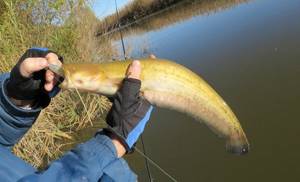
Small catfish must be released
With a rod
Having installed a stand for the rod on the shore and equipped the hook with a nozzle, cast the tackle, paying attention to the accuracy of the bait, in view of its possible dislocation with an excessively strong swing and subsequent impact on the water.
Important! The equipment that has reached the bottom is pulled up with a reel until the cord is fully tensioned, which can be seen from the tense quiver tip of the rod.
After tensioning, the cord is equipped with an alarm and a bite is expected. Catfish bite sharply, picking up the bait and continuing their movement without pause. Such a pull should be immediately accompanied by a hook and, sensing the resistance of a fish that has landed on the hook, you must promptly begin to land it. Fishing is carried out with a reel, gradually winding the cord and tiring the fish by pulling the form in the direction opposite to the trajectory of the fish. The mustachioed predator is quite strong and resilient, and the fight with a large individual can continue for dozens of minutes, and sometimes hours, with varying success.
Tired fish are identified by the release of bubbles to the surface, which is the moment for more decisive action to reel in the line. The best technique is to drag the trophy onto a flat bank. Small catfish are immediately placed on the kukan. The large fish are caught in the head area with a humanizer and after this manipulation the hook is released and the specimen is croaked, placing it on a rope near the shore.
Without a rod
It is more convenient to cast a classic donkey by placing a load from the boat. In this case, the live bait remains guaranteed to be intact, and the tackle itself is controlled for installation in order to avoid tangling of the leads. Biting, like hooking a fish, is similar to the previous fishing method, but fishing has significant differences. Catfish from the shore are taken on a classic donka with strict control of laying the extended cord in a certain place, in a way different from rings and loops. The hunter must wear overalls on his hands to prevent cuts from the fishing line . Sudden withdrawals of fish are accompanied by the fisherman lowering a small amount of line and then holding the fish, which must be repeated until the resistance of the predator subsides. They take catfish into the landing net close to the shore. You can use a net only after catching an individual no more than five to seven kilograms. A large predator is pulled ashore by grabbing it in the shallows with their hands under the gills or taking it by the lip.
Fishing depending on the season
When taking a professional approach to catfishing, you must take into account the season. This will help you not only get a rich catch, but also get an unforgettable pleasure from fishing or, perhaps, catching the largest trophy.
Spring
Features of hunting for catfish in spring include:
- After winter, the fish are hungry and pay attention to all baits. In addition, appetite increases significantly before spawning.
- It is possible to catch large specimens.
- Only after the water warms up to 10 degrees Celsius does the catfish emerge from its winter holes and begin to actively hunt.
- The fish behaves carefully and does not swim far from the pits where they spent the winter.
- Fishing is active exclusively during the daytime.
- Catfish bite best in shallow water.
Autumn
In autumn, the behavior of fish changes significantly. When going fishing, consider the following:
- active hunting takes place exclusively at night;
- after summer the fish becomes calmer, attacks exclusively from ambush;
- The most suitable time for fishing is September. With the onset of severe frosts, the catfish freezes and stops feeding;
- In search of food, the fish comes to the shore.
Catching catfish on a donk from a boat and precautions
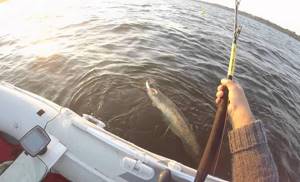
Catfish are caught from a boat using hooks with a reel and rods with the already described type of bottom mounting. To attach fish to the fishing site, you can use a quok, which will be an additional incentive for the predator to search for bait. It is worth paying special attention to safety measures when fishing from boats, carrying out the fishing process with a partner who can help in landing the caught giant. The key points are to avoid winding the cord around your hand when landing fish and to randomly throw the cord into the boat when winding it up while the fish is sitting on the hook.
Failure to comply with these recommendations directly threatens the safety of the fisherman’s life. After all, a cord wound around the hand or a noose tightening the leg when biting a fish over 50 kg can easily pull the angler over the side of the boat and cause serious trouble for him. It is also not recommended to lift particularly large trophies into the boat, in order to avoid its flooding if it capsizes. It is better to tow the fish to a flat bank and place it on a kukan there.
Do-it-yourself tackle for catfish from the shore
To make fishing gear we will need:
- Fishing line or braid.
- Hooks.
- Cargo.
The device is very quick and simple:
- A weight is attached to the end of the homemade device. Leashes are tied above the load, keeping a space of 30 centimeters.
- Then this entire device is attached to the main fishing line.
Shore fishing technique:
- In order for fishing to take place with a positive result, we first look for a place to fish. It is very important that the location found is in an area where bait can be fed from the shore.
- Since catfish mainly bite at night, it is better to equip a place for night fishing in advance. Clear a place on the shore. Prepare gear, feed the place.
- Don’t forget that catfish almost never swallow bait right away. He is very careful and at the slightest sounds or premature movements the catfish will simply swim away.
- He begins to bite off the bait in small pieces. Maybe swim a short distance five times, then swim back and start biting the bait again. And only if he is sure that nothing threatens him can he completely swallow the bait.
- After making the cast, you need to wait until the nozzle completely sinks to the bottom.
- Then you need to select a medium tension line and put the reel on the ratchet.
- Attach a bell to the fishing line closer to the base.
- If there is no bite for a long time, you can recast or simply tighten the line a little. Do not forget to periodically add bait to the water. In most cases, this helps and when you feel a bite, immediately hook it with a sweeping movement.
- If you feel that a catfish has swallowed a hook, now the main task is to prevent it from swimming under any obstacles or lying on the bottom.
- If, after all, the catfish lies on the bottom and there is no way to pull it out, then you need to create noise, which these fish categorically cannot stand. To do this, you can tap something on the water.
- Be prepared to put a lot of patience and physical strength into catching this fish.
- And of course, it’s almost impossible to cope without a partner. A partner will have to help pull the catfish ashore. For this, a hook and a landing net are used.
- If you come across a very large fish, then there is hope that another catfish is swimming somewhere nearby. Since very large catfish rarely swim long distances.
By adhering to general information and competent advice, you will not only be able to choose the necessary gear and everything else yourself, but also go home with a good catch.
